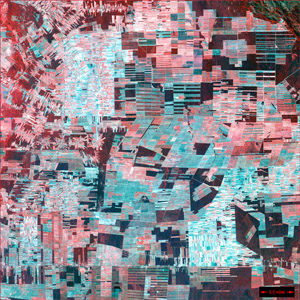The new media are not bridges between man and nature: they are nature.
McLuhan (1969), Counter-Blast
Nature with a capital N, according to McLuhan, was a creation of literate Greeks, an act informed by the phonetic alphabet with its visual bias and the acts of classification by cultures that had exchanged an ear for an eye. This visual world of Euclidean space and compartmentalized knowledge allowed for absolute control over perspective and thus enabled a detached point of view where abstracted continuous spaces could be extended to enframe the world and define all phenomena according to its “Natural Law”. The civilized children of “Nature” lived in an environment “surrounded by an abstract explicit visual technology of uniform time and uniform continuous space in which “cause” is efficient and sequential, and things move and happen on single planes and in successive order” (The Gutenberg Galaxy, p . 19).
Sputnik, the first satellite to orbit the Earth and, therefore, for McLuhan, the first extension of Earth, pushed aside Nature as laid out within the grid of visual space and retrieved the idea of ecology, or dynamic interplay and involvement as the key characteristics of the world. McLuhan associated such ecological thinking with tribal cultures, cultures that lived in an acoustic world immersed in and involved with one another. In an elliptical orbit approximately 1000 kilometers above the Earth, Sputnik circled the planet every 96 minutes at a speed of 29,000 kilometers an hour. For 22 days, Sputnik’s beeps were heard by people all around the world, and these sounds signaled the birth of the global village, a world where we are all involved, tribally, in one another on the planet. As McLuhan put it, because of Sputnik, “ ‘Spaceship earth’ was recognized as having no passengers, but only crew.” Being all on the same ship makes a detached point of view seem positively irresponsible (if not downright dangerous!).
A further impact of Sputnik for McLuhan was how, by encircling the plant, the satellite turned the world into content or an information environment that could be programmed. First in a series of beeps and then, over the years, in an increasing data stream of information, these orbiting extensions fed back to the earth information about itself using a range of imaging and remote sensing technologies. And now, with public access to satellite imagery available in real time, it is possible to use applications like Google Earth to explore not only images of the Earth, but layers of data created by private and public groups to highlight local and global issues and experiences. The planet can, in effect, be programmed visually, using such data, and these programmed spaces have an impact on socio-political and cultural ideas concerning how we cohabit the planet. With our nervous systems outerred and orbiting our planet, we can’t help but engage in ecological thinking. These orbiting extensions of ourselves have reconfigured and transformed our relationship to our planet and to one another.
References:
Marshall McLuhan. (1962). The Gutenberg Galaxy: The making of Typographic Man. Toronto: University of Toronto Press.
Marshall McLuhan. (1969) Counter-Blast. Toronto: McClelland and Stewart.
Marshall McLuhan. (1977) “The Rise and Fall of Nature.” Journal of Communication, 27, 80-81.
